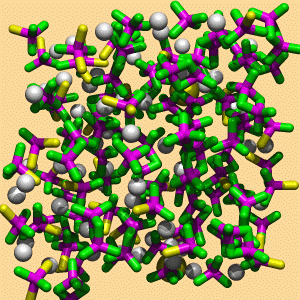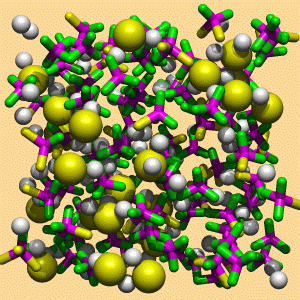
Lithium is white, aluminium magenta (purple), chlorine green, iodine
yellow. The Al-Cl and Al-I bonds are shown as bars instead of balls.
Atoms in molecules and complex ions (AlCl3I-,
Al2Cl6, ...) are shifted by the appropriate
multiple of the box size not to be broken because of the periodic
boundary conditions.
[J. Kolafa professional homepage] [J. Kolafa private homepage]
Yi-Chia Lee, Jiri Kolafa, Larry A. Curtiss, Mark A. Ratner, and Duward F. Shriver
Molten Salt Electrolytes. I. Experimental and Theoretical Studies of LiI/AlCl3
J. Chem. Phys. 114, 9998-10009 (2001)
Molten LiI/AlCl3 with different molar ratios of LiI to
AlCl3 were prepared and characterized by Raman
spectroscopy, thermal analysis, and impedance measurements. The
LiI/AlCl3 adducts melt at 70-80oC and the Raman
spectrum indicates that a variety of haloaluminates exist in the
system. The 1:1 adduct has the highest ionic conductivity, 2e-6 S/cm
at 25oC, and the conductivity increases dramatically as the
temperature is increased. Molecular dynamics simulations suggest that
several haloaluminates are present in the adducts. Ab initio
calculations were carried out on the species that were predicted by MD
simulations and these results were compared with Raman spectra, and
good agreement was obtained. Several ns long MD simulations allowed
us to study the conductivity and relaxation processes in the 1:1 and
1:2 melts at higher temperatures.
Yi-Chia Lee, Jiri Kolafa, and Larry A. Curtiss
Force field and molecular dynamics of molten AlCl3/LiI and AlCl3/LiSCN
Poster presented at The CCP5 Annual Meeting 2000 - Molecular Simulation in the 21st Century, University of Surrey, Guildford, UK, 2nd-5th July 2000
Adducts of aluminimum chloride with different alkali metal salts are crystalline materials with low melting points (LiI/AlCl3) or glasses (LiSCN/AlCl3). Complexing of anions with AlCl3 delocalizes the electric charge and thus increases the ionic conductivity. These systems could therefore be useful as electrolytes in high energy density batteries. The proposed force field is based on the exp-6 (Buckingham) potential with the Busing combining rules for the exp-term and the r-6 attraction for anions. The Li+-anion interactions are modified by an r-12 term. The anions are polarizable and the induced dipole is damped at close cation-anion separations by the shell-core model [1]. The model of the thiocyanate anion (*-S-*--C--*-N-*) uses four auxiliary charges (*) and polarizability tensors at S and N. The parameters for Al3+, Cl-, and I- are taken from [1], the model of Li+ is based on the LiCl and LiI crystals and the properties of the LiCl pair calculated at the MP2/6-31G* level, and the model of SCN- is fitted to geometry and vibrational spectra (MP2/6-31G*) of SCN- [2] and different conformers of AlCl2SCN, AlCl3SCN-, and LiSCN [3]. The MD calculations are performed using MACSIMUS [4] implementing a novel predictor-corrector scheme for polarizable force fields [5]. Various structural characteristics (correlation functions, coordination numbers, oligomer analysis) as well as diffusion coefficients and conductivity are measured and analyzed.
[1] Z. Akdeniz, G. Pastore, M. P. Tosi,
Phys. Chem. Liq. 32, 191 (1996);
Z. Akdeniz, G. Pastore, M. P. Tosi,
Nuovo Cimento 20, 595 (1998).
[2] P. W. Schultz, G. E. Leroi, J. F. Harrison,
Molec. Phys. 88, 217 (1996);
S. T. Howard,
Molec. Phys. 85, 395 (1995).
[3] T. Veszpremi, T. Pasinszki, M. Feher,
J. Am. Chem. Soc. 116, 6303 (1994).
[4] MACSIMUS.
[5] J. Kolafa,
Molec. Simul. 18, 193 (1996).
